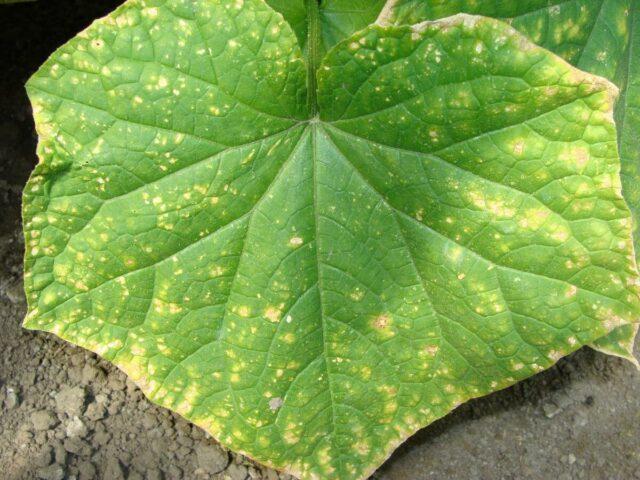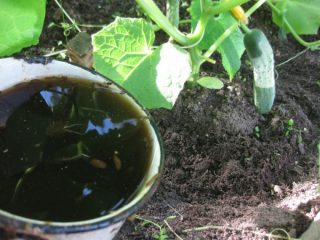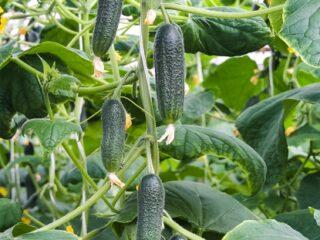Content
Cucumber chlorosis is an infection that often affects this vegetable crop. It can harm not only young, but also already mature bushes growing both indoors and outdoors. There are quite a few reasons for the development of the disease, but the main ones are failure to follow the rules for caring for cucumbers or a lack of any elements.
Description and photo of chlorosis
Infection with chlorosis is indicated by yellowed leaves of the plant, which over time begin to wither and fall off. If measures are not taken in time, the cucumber bushes will die. The first sign of chlorosis is the appearance of yellow veins on the edges of the leaf blades. First, the cucumber leaves partially lose their color, begin to curl, new shoots become smaller, and the buds become deformed. Gradually, the disease progresses, the tips of the shoots weaken and dry, and rotting serous areas appear on the plant. If left untreated, a moldy fungus develops, causing the roots of the crop to rot. You can see cucumber bushes suffering from chlorosis in more detail in the photo below.

The disease spreads quickly and can only be treated at the very beginning
Types of disease
In nature, there are several types of chlorosis, each of them is dangerous in its own way and appears due to a number of reasons. The following types of disease are found:
- Infectious. Spread by insects.
The infectious species is caused by pathogenic organisms, fungi, viruses
- Non-infectious. It often occurs due to unfavorable weather conditions.
A non-infectious disease can occur due to a lack of nutrients, errors in caring for cucumbers and when sowing them
- Edaphic.
The edaphic type of disease occurs when there is a lot of salts, lime in the soil or during periods of heavy rainfall
- Carbonate.
Carbonate chlorosis is caused by high levels of alkali in the soil.
Causes
The appearance of chlorosis on cucumbers can occur for various reasons, and, as many gardeners note, identifying them is quite problematic. Usually they lie in a disruption in the formation of chlorophyll and, consequently, in low photosynthetic activity. Chlorosis often occurs due to a lack of substances necessary for the normal development of cucumbers. It can also be caused by crop poisoning.
Infectious chlorosis can begin due to possible infection from other plants or the transfer of bacterial and fungal spores by insects. This type of disease is also called mosaic or spotting.
Non-infectious chlorosis manifests itself when there is a deficiency of iron, sulfur, zinc and other useful substances in the soil. It occurs quite often.
The development of chlorosis can also occur for other reasons, for example:
- soil acidity - makes it difficult for the roots to absorb necessary elements;
- dense planting of bushes, due to which the roots of cucumbers are crowded and they do not receive enough oxygen;
- damage to bushes at the time of picking or formation reduces the immunity of the crop and increases its susceptibility to chlorosis;
- poor-quality soil drainage – provokes a large accumulation of water near the root system of the plant.
Less commonly, chlorosis can occur due to exposure to external factors: insufficient sunlight, drafts, improper organization of watering of cucumbers, too high or low temperature, high humidity.
Cucumbers grown in a greenhouse usually suffer from disease due to the special microclimate under the shelter and the rarely changing soil.

In particular, the cause of chlorosis is insufficient or excessive amounts of microelements in the soil
How to treat chlorosis on cucumbers in a greenhouse
Since the disease is quite treatable at the initial stage, it is important not to miss the moment of its appearance. But before starting treatment, it is advisable to identify the cause of the disease, and this is not always possible.
For cucumbers grown in greenhouses, ammonium sulfate cannot be used to combat chlorosis, since the soil is not washed due to the film. In greenhouses, vegetable crops are treated with ballast-free preparations.
Adding minerals
To eliminate chlorosis caused by a lack of microelements, gardeners usually replenish them. To do this, use root or foliar feeding of cucumbers.
In different situations, they resort to the use of certain drugs:
- for iron deficiency - Ferovit, Ferrylene, Micro-Fe, Chelate;
- due to the low calcium content - wood ash, lime, egg shells;
- with a lack of sulfur - Kalimagnesia, Azofoska;
- due to magnesium deficiency - dolomite flour, Mag-Bor, magnesium sulfate;
- due to low zinc levels - zinc oxide, superphosphate.
Agrekop or Ferrylene are used as universal means to combat cucumber chlorosis. But these drugs are suitable only at the very beginning of the disease. At the time of treatment, weather conditions and the extent of the lesion are taken into account. The procedure is carried out after seven o'clock in the evening or before ten in the morning in warm, calm weather.
To determine which substance is missing, you need to carefully examine the affected areas of the plant. Determine the cause of the disease, paying attention to the following features:
- If there are thin veins on the leaf blades of cucumbers with interveinal areas between them, first the young leaves turn yellow or turn brown, then the plant is deficient in iron. And if the areas between the veins become lighter, then, on the contrary, there is too much substance.
- When the veins themselves turn yellow, this is a signal that the cucumbers do not have enough sulfur.
- If the veins on the lower leaves turn yellow or brown, it means the crop needs nitrogen. And if the leaf blades begin to curl, there is too much substance.
- In case of yellowing of the interveinal space of the old foliage of cucumbers and their pallor on the underside, fertilizing with magnesium is required. But if the greens darken, it means there is more mineral in the soil than needed.
- If the leaf blades begin to rust along the edges, then the cucumbers require manganese, and if brown spots appear on them, then its amount, on the contrary, is higher than normal.
- A signal of a lack of potassium is the appearance of a brown color on greenery without initial yellowing, and its excess is indicated by the appearance of openwork patterns on the foliage of cucumbers.

Dosed, prompt use of chemistry is the main opportunity to stop chlorosis
other methods
When chlorosis of cucumbers does not occur due to an imbalance of minerals, their addition to the soil will not be able to protect the planting, and other methods of combating the disease come to the rescue:
- If the disease is caused by unfavorable conditions, for example, waterlogging, then watering is stopped and drainage ditches are made in the beds. During frosts, fertilize cucumbers. When exposed to sunlight, plants shade.
- If chlorosis begins to progress due to an excess of minerals, then first of all they stop fertilizing the crop, and after that they try to restore the balance of elements.
- If the cause of the disease is pests, the cucumbers are sprayed with means to destroy them.
In addition, it is very important to stop the spread of chlorosis. To do this, it is imperative that all damaged parts of the plant are cut off and taken outside the greenhouse and garden. It’s even better if the infected leaves and stems of cucumbers are burned.
Preventive measures
It is much more effective to prevent chlorosis than to treat it, so the disease should be prevented: follow the technology for growing cucumbers, properly care for them, and water them moderately. Designate the area for garden beds in a bright place; do not plant bushes at a small distance from each other. Fertilize the soil with organic matter and minerals in a timely manner. In cases where it is unclear what exactly is missing, it is better to use special mineral complexes for cucumbers, for example, Kemira Lux, Florist or Uniflor Micro.
Also, measures to prevent chlorosis include:
- disinfection of equipment;
- disinfection of soil and planting material;
- pest control.

The most dangerous type of disease for cucumbers is infectious
Varieties resistant to chlorosis
Every year, breeders try to develop new varieties of cucumbers that are becoming more and more resistant to various diseases, including chlorosis. Currently, the following hybrids have the best immunity:
- early ripening varieties - Nightingale, Masha, Knyazhna, Primadonna, Lastochka, Boy-with-Palchik;
- varieties of medium ripening - Zhuravlenok, Natalie, Murashka, Sudar, Pasadena, Benefit, Phoenix Plus, Octopus;
- late cucumbers – Leandro, Rodnichok, Golubchik.
These vegetable varieties very rarely suffer from chlorosis. But if you do not follow the recommended technologies when growing them, the disease will have every chance of appearing.
Conclusion
Cucumber chlorosis is an infectious disease of the crop that occurs when exposed to internal and external factors. To combat the problem, various chemical compounds are used, the choice of which depends on the type of disease.At the initial stage, the disease is easily treatable, but in an advanced situation, it is better to destroy the affected cucumber bushes than to allow it to spread.












